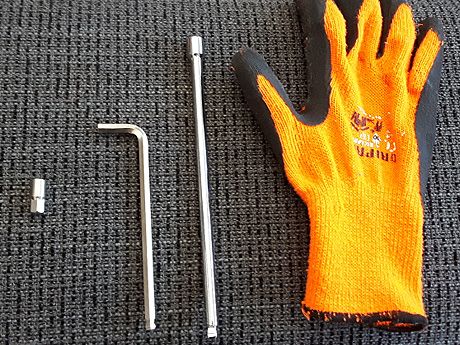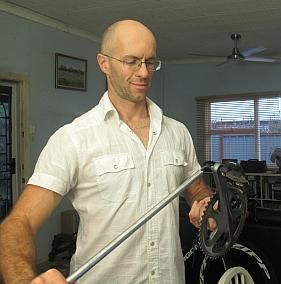How to easily unscrew hard pedals loose or tighten them to the specified torque
In fact, the simple fact of using pedals, with the rider’s weight and the pressure exerted simply by riding, will automatically tighten them after just a few kilometers. Here’s my method to safely unscrew them (or tighten them to the specified torque).

In this article I share with you my method to remove that pedal from the crankset in a safer way than just with a simple Allen key.
I will use the example of a standard 12 mm diameter pedal screw, with a 8 mm hexagonal hole at the back.
Remember, NEVER hit the tip of an Allen key with a hammer; the elasticity of the Allen key will make it bounce back, hence absorbing the energy of the hammer. It’s useless, and may be dangerous.
The tools you’ll need

- get hold of a fat 8 mm Allen key, or even a 6 mm Allen key, with the right adapter for the diameter of the pedal screw (8 mm)
- A 6 mm square end wrench extension, or a metal pipe (copper, aluminium) - obviously compatible with the diameter of the Allen key used -, needs to be at least 15 cm long. The extension is easy to get, and quite inexpensive, on any good DIY online shop.
- Protection gloves, for when it’ll get loose.
Advice
The longer the pipe or the extension, the more lever effect it will have, the easier it’ll be to unscrew the hardest cases.
Method

Reminder on the rotation way
On many modern bikes, pedals are screwed and unscrewed from inside.
Whereas you’re looking at their axis from inside, ask yourself if you’ll turn the Allen key clockwise, or anticlockwise.
I here remind you that on a standard bike, the right pedal (cranckset side) is unscrewed clockwise, whereas the left pedal is unscrewed anticlowise (much like a normal screw in fact).
All right, but that damned crankset keeps spinning!
As shown below, I suggest to use my technique for a good grip of the crankset, thus unscrewing the axial screw of the pedal without struggling, and without making the crankset spin either.


Right pedal (above)
The trick is to block the opposite pedal, the left one, between your thighs ;
stand facing the screw, set the key horizontally, in front of your right hip, to achieve best lever effect;
push on the key vertically, downwards, until it the screw gets loose.
Left pedal (left)
This time, stand behind the screw;
see the position of the crank arm on the picture: in front of the left hip;
use your left hand for two purposes, A, immobilise the crank arm, holding the pedal, thus preventing the annoying rotation of the crankset, and B, keep the key well sit inside the screw;
once again, place the key horizontally, and push downwards.
Yeah, except my composed wrench system bends, and still doesn’t get the pedal loose!
Press harder! Tell yourself the metal has an interesting property, elasticity, that will allow your composed wrench system to bend without breaking. The screw will get loose eventually, especially if you press hard, with intermittent strokes, harder every time.
Using the system to tighten
If you unscrew a pedal, you’ll be looking at screwing one back one day. If you need to screw pedals at the proper torque, found in their technical specifications on their manufacturer’s website, you can also use that setup to do so.
Obviously you’ll need to revert the positions seen above while unscrewing.
Tighten the right pedal
A right pedal gets screwed anticlockwise, therefore you’ll screw while standing behind it, as shown above, on the picture where I unscrewed the left one.
Tighten the left pedal
As far as the left pedal is concerned, it gets screwed clockwise, so stand facing that screw, with the right hand side crank arm blocked bretween your thighs. It is the same method as the one used yo unscrew the right pedal.
How do I know I apply the correct torque?
Pedals need to be screwed tight, but how tight? If you want to be accurate, start by spotting the the recommended torque in the appropriate manual online. Next, measure the length of your composed key, i.e. the length of the straight part of the L-shape wrench. Then, use a clever calculation, quite easy in fact, that I develop in the following article Tightening a bolt without a torque wrench
Example
I hereafter summarise the calculation, that is in fact just a multiplication.
Let’s consider a required torque of 40 N.m, which is the actual torque required by my LOOK Kéo Blade.
Let my wrench length be 23 cm, or 0.23 meter, I therefore have to apply a tightening force equals to 40 / 0.23 = 174 Newton, that I divide by 9.8, the value of gravity, so that I get the corresponding weight in kg, i.e. about 18 kg
All you have to do now is to follow the method I give in the article, for how to apply this exact force onto the wrench.
Warning
Wear gloves to avoid any injuries, including cuts if your wrench rips off the pedal screw hole all of a sudden. Make sure your wrench sits well at the back of the hole of the pedal.
Can’t finish without the usual legal tag: I give this method and this information to help out, but I decline any responsibility in any event resulting in using this information improperly, or if an accident occurred following the application of this method. In any case, please use common sense, and get a cycling gear professional if you think any task is out of your reach.



